Do you have to make relief cuts to get the foam to conform under the ring or is it stretchy enough?I can't take credit for that. Not my idea. A fellow turner on here (and grizzly owner as I recall) posted his and I just copied it. It works great, BTW. holds the foam tight to rim and makes changing easy. Just use the pipe size intended for use with the coupling, cut a tiny section out on the bandsaw leaving a gap of about 1/8" and it'll snap into place over the foam. I started with narrow cuts, gradually widening the gap until they fit nicely. No gluing. Just have to keep solvents off the electrical tape.
-
Beware of Counterfeit Woodturning Tools (click here for details) -
Johnathan Silwones is starting a new AAW chapter, Southern Alleghenies Woodturners, in Johnstown, PA. (click here for details) -
Congratulations to Peter Jacobson for "Red Winged Burl Bowl" being selected as Turning of the Week for April 29, 2024 (click here for details) -
Welcome new registering member. Your username must be your real First and Last name (for example: John Doe). "Screen names" and "handles" are not allowed and your registration will be deleted if you don't use your real name. Also, do not use all caps nor all lower case.
You are using an out of date browser. It may not display this or other websites correctly.
You should upgrade or use an alternative browser.
You should upgrade or use an alternative browser.
small friction drive chucks
- Thread starter Sam Fleisher
- Start date
I cut one small v on the inside to prevent the foam from overlapping. If the material overlaps it may buckle and cause a slight bump on the edge causing it to not run true. But if you take the time to get the foam ends to butt up nicely to one another (v relief on inside smaller dimension) there is no buckling.Do you have to make relief cuts to get the foam to conform under the ring or is it stretchy enough?
Correct.
What you said! I'm not good at this kind of math - but it looks like that just determines the surface area. The reason a vacuum chuck works is the amount of atmospheric air pressure on the piece - pressing against the chuck. At sea level the atmospheric air pressure is about 14.7 lbs. psi. Therefore, using Doug's 4" example approx. 185 lbs. of pressure is holding the piece on the chuck. Of course, this doesn't take into account your altitude where you live, porosity of the wood, leakage in the system, etc.
Well, perhaps it was not explicitly clear that I was stating area, but….area is in “squared units”, inches squared, force is in lbs-force. The pressure value is equal to the amount of vacuum pulled, and it depends on what units the gauge is in as well as how the gauge is marked. Typically a vacuum gauge is marked in units of vacuum- psi, in hg, mm hg, in h2o, mm h2o. Too many variables to address. Get the reading of vacuum, convert to psi, and multiply it by the area of the opening in in^2. The most important thing is to have “measurement unit agreement”.The pressure is the amount of vacuum you generate, depends how your gauge reads for how to calculate.
A 2” opening is 3.1416 in^2 (pi).
A 4” opening is 12.57 in^2, 4x the force for the same vacuum amount. The force increase exponentially, as it is an exponential eq (r^2).
A vacuum gauge will self compensate for changes in atm pressure, so altitude is not an issue.
No, I pull up the tail stock to help hold it in place (see photo). When I turn off a tenon with a jam chuck I keep the rpms on my lathe down lower than what I normally turn at. Here are photos of my rubber chucky and a mock up of how I use it to hold a bowl. I mostly turn bowls that are 4 to 6-7 inches so this chucky that's 3" works for me.Does the bowl move around any when you turn the tenon off if you were to do that?
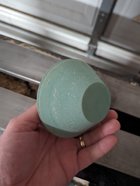
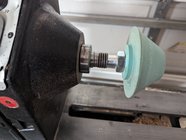
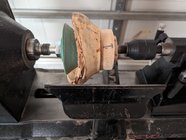
- Joined
- Apr 27, 2004
- Messages
- 8,652
- Likes
- 5,014
- Location
- Lakeland, Florida
- Website
- www.hockenberywoodturning.com
Similar to @Charles Cadenhead
I use a wooden friction drive. It needs to be checked for true and trued up if needed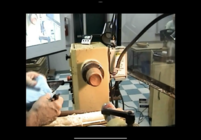
Also needs a pad. I usually use paper towel in demos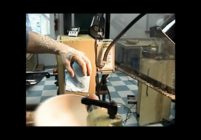
I finish turn the foot underside with a spindle gouge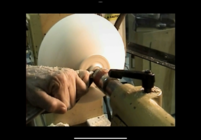
Last step is to turn off the nub at 3 rpm hand turning the bowl.
I use a wooden friction drive. It needs to be checked for true and trued up if needed

Also needs a pad. I usually use paper towel in demos

I finish turn the foot underside with a spindle gouge

Last step is to turn off the nub at 3 rpm hand turning the bowl.

Tom Gall
TOTW Team
I think we're on the same page for the most part, Doug.Well, perhaps it was not explicitly clear that I was stating area, but….area is in “squared units”, inches squared, force is in lbs-force. The pressure value is equal to the amount of vacuum pulled, and it depends on what units the gauge is in as well as how the gauge is marked. Typically a vacuum gauge is marked in units of vacuum- psi, in hg, mm hg, in h2o, mm h2o. Too many variables to address. Get the reading of vacuum, convert to psi, and multiply it by the area of the opening in in^2. The most important thing is to have “measurement unit agreement”.
A vacuum gauge will self compensate for changes in atm pressure, so altitude is not an issue.
But, a vacuum gauge doesn't compensate for atmospheric pressure - it just takes a reading ... just use it as an indicator for your system. And altitude does matter - there is more atmospheric pressure (psi) at sea level than at the top of Mt. Everest. The vac pump just evacuates the air from your chuck so that the atmospheric pressure presses the workpiece against the chuck. The larger the area (chuck rim) the more pressure. Theoretically, if there was no atmospheric pressure you would never get more holding power (30hg max. - whatever that is) - no matter the surface area of the chuck/workpiece.
Well, I think the magic number for me will be three. small, medium, large. OK, possibility of four if I throw a plate in there.
But we're all missing the poll of whether to stick a tenon or a mortise on the homemade friction chucks that are too small in diameter to use my faceplate rings on. Guess I could make them big enough for the ring and taper down to small, medium, and I already have a large friction drive. (loosely based on an article in a woodcraft magazine I found online)
But we're all missing the poll of whether to stick a tenon or a mortise on the homemade friction chucks that are too small in diameter to use my faceplate rings on. Guess I could make them big enough for the ring and taper down to small, medium, and I already have a large friction drive. (loosely based on an article in a woodcraft magazine I found online)
- Joined
- Apr 27, 2004
- Messages
- 8,652
- Likes
- 5,014
- Location
- Lakeland, Florida
- Website
- www.hockenberywoodturning.com
I use tenons on mineWell, I think the magic number for me will be three. small, medium, large. OK, possibility of four if I throw a plate in there.
But we're all missing the poll of whether to stick a tenon or a mortise on the homemade friction chucks that are too small in diameter to use my faceplate rings on. Guess I could make them big enough for the ring and taper down to small, medium, and I already have a large friction drive. (loosely based on an article in a woodcraft magazine I found online)
This is one I use with double sided tape for an ornament disc.
But it is a perfectly good friction drive too
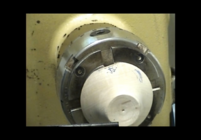
Hollow it a bit more and it can be a ball cup for a 2” ball
I suspect we are "talking past each other". With measuring instruments, compensation means adapting or correcting for changes such as temperature or pressure, etc, that could effect the reading. Typically folks on here are using bourdon tube style gauges, which compensate for altitude. A reading of 5 psi vacuum at sea level and 5 psi at 5000ft is saying the evacuated space is 5 psi below the atmosphere around it, hence the gauge compensates for altitude. The differential pressure between the evacuated space and the local atm pressure is what generates the force.I think we're on the same page for the most part, Doug.
But, a vacuum gauge doesn't compensate for atmospheric pressure - it just takes a reading ... just use it as an indicator for your system. And altitude does matter - there is more atmospheric pressure (psi) at sea level than at the top of Mt. Everest. The vac pump just evacuates the air from your chuck so that the atmospheric pressure presses the workpiece against the chuck. The larger the area (chuck rim) the more pressure. Theoretically, if there was no atmospheric pressure you would never get more holding power (30hg max. - whatever that is) - no matter the surface area of the chuck/workpiece.
Everyone here knows atm pressure reduces with altitude, thus the amount of vacuum that can be generated is reduced, therefore the max force that can be generated with the same diameter vac chuck is reduced.
FYI - the atm pressure reported by weather apps etc is reported for sea level. If you are in Denver, you have to look up the reduction of atm or barometric pressure due to ~5,200 ft of altitude, and subtract that value from the weather report value. The correction for altitude never changes, only the local atm pressure as weather moves through.
I used an app on my phone earlier to find out I am 648 feet above sea level. Should be good enough to get some good vacuum if all the other variables line up? wood, seal etc?I suspect we are "talking past each other". With measuring instruments, compensation means adapting or correcting for changes such as temperature or pressure, etc, that could effect the reading. Typically folks on here are using bourdon tube style gauges, which compensate for altitude. A reading of 5 psi vacuum at sea level and 5 psi at 5000ft is saying the evacuated space is 5 psi below the atmosphere around it, hence the gauge compensates for altitude. The differential pressure between the evacuated space and the local atm pressure is what generates the force.
Everyone here knows atm pressure reduces with altitude, thus the amount of vacuum that can be generated is reduced, therefore the max force that can be generated with the same diameter vac chuck is reduced.
FYI - the atm pressure reported by weather apps etc is reported for sea level. If you are in Denver, you have to look up the reduction of atm or barometric pressure due to ~5,200 ft of altitude, and subtract that value from the weather report value. The correction for altitude never changes, only the local atm pressure as weather moves through.
Oh yeah. Most of us are below ~2000 ft, no big deal.I used an app on my phone earlier to find out I am 648 feet above sea level. Should be good enough to get some good vacuum if all the other variables line up? wood, seal etc?
Suede leather works well for a seal, and so far it has not left any marks on the piece. One advantage is to keep the vacuum low while you are positioning the piece, because the leather is not sticky and you can easily adjust the piece. Then turn up the vacuum so it holds very well.
